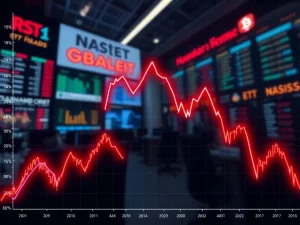Unprecedented Bitcoin Whale Moves Stunning $4.7 Billion BTC

The crypto world is abuzz! An extraordinary event has unfolded, captivating the attention of investors and analysts alike: a colossal Bitcoin whale, previously dormant for an astounding 14 years, has stirred once more. This isn’t just any transaction; we’re talking about an unprecedented Bitcoin whale shifting billions of dollars worth of BTC, raising questions and sparking intense speculation across the digital asset landscape. What does this massive BTC movement signify for the broader crypto market impact? Let’s dive in.
The Awakening of a Gigantic Bitcoin Whale
For years, the crypto community has tracked the movements of large holders, often referred to as ‘whales,’ due to their potential to influence market dynamics. However, the recent activity of this particular Bitcoin whale stands out. First identified by blockchain analytics firm Lookonchain in early July, this entity’s wallets received Bitcoin back in April and May of 2011. Imagine that – acquiring BTC when it was mere cents or a few dollars, and then holding it for over a decade! This long period of dormancy only adds to the mystique and significance of its recent awakening.
Initially, this whale was noted to hold a staggering 80,000 Bitcoin. The initial stirrings began on July 4th, marking the first time in 14 years that these ancient holdings saw any activity. At that time, the whale’s portfolio was spread across eight distinct wallets. Two of these wallets acquired 20,000 BTC on April 2, 2011, when Bitcoin traded for approximately $0.78, valuing that portion at a humble $15,600. The remaining six wallets received 60,009 BTC on May 4, 2011, at a price of about $3.37 per BTC, totaling around $202,000. These figures offer a stark reminder of Bitcoin’s monumental growth.
Understanding the Massive BTC Movement
The recent activity isn’t just a minor shuffle; it’s a significant two-part BTC movement that has sent ripples. Days after initially transferring billions in Bitcoin to Galaxy Digital, the whale has now shifted the second half of its enormous stack to a brand-new wallet. According to Lookonchain, this latest transfer involved 40,192 Bitcoin, valued at an astonishing $4.77 billion at current market prices. This follows a previous transfer of 40,009 BTC to asset manager Galaxy Digital just days earlier, as noted by Nansen data. What’s particularly intriguing is that Galaxy Digital subsequently sent 6,000 BTC directly to major crypto exchanges like Binance and Bybit. These movements have fueled widespread speculation that a sale might be underway or being prepared.
While internal transfers among a whale’s own wallets are common for security or organizational purposes, the sheer scale and the direct transfers to exchanges by a third party like Galaxy Digital raise eyebrows. Such large-scale movements, especially from long-dormant wallets, can signal several possibilities:
- Security Consolidation: The whale might be moving funds to more secure or newer wallet addresses.
- OTC Sale Preparation: Transferring to an asset manager like Galaxy Digital often precedes an Over-The-Counter (OTC) sale, which allows for large transactions without directly impacting exchange order books.
- Liquidity Generation: A portion might be sold to realize profits or to fund other ventures.
- Rebalancing Portfolio: Diversifying holdings or reallocating assets.
The implications of such a large amount of Bitcoin potentially entering the market are a key area of focus for anyone monitoring the crypto market impact.
Navigating the Crypto Market Impact of Whale Activity
The actions of large holders, especially those with significant portions of Bitcoin’s circulating supply, can have a tangible crypto market impact. When a whale moves billions of dollars worth of BTC, it naturally triggers questions about potential selling pressure. Even if the intention is not an immediate sell-off, the mere possibility can influence market sentiment. Traders and investors closely monitor such transfers, trying to decipher the whale’s intentions.
Consider the potential scenarios:
- Bearish Sentiment: If the market perceives the whale is preparing for a large sale, it could lead to fear and potentially downward price pressure, as supply increases.
- Bullish Sentiment: Conversely, if the movements are interpreted as internal transfers for security or strategic rebalancing, it might have little negative impact, or even be seen as a sign of long-term holding confidence.
- Liquidity Test: A massive sale would test the market’s current liquidity and depth, revealing how much demand exists at various price points.
The market’s reaction is often a mix of data analysis and psychological interpretation. The fact that this whale’s coins are ‘Satoshi era coins’ only adds to the intrigue, given their historical significance and the massive unrealized gains.
The Significance of Satoshi Era Coins
The term ‘Satoshi era coins’ refers to Bitcoin acquired in the very early days of the network, often within the first few years of its existence. These coins hold a special place in Bitcoin’s history. The whale’s holdings, acquired in 2011, firmly fall into this category. The original value of these coins was negligible compared to their multi-billion dollar valuation today. This incredible appreciation highlights Bitcoin’s journey from a niche digital experiment to a global financial asset.
Who else holds significant amounts of these early coins? The most famous example is Bitcoin’s pseudonymous creator, Satoshi Nakamoto, who is estimated to hold around 1.096 million BTC across thousands of wallets. What’s truly remarkable is that Satoshi’s holdings have never been moved or sold, remaining untouched as a testament to the creator’s vision or disappearance. Other notable early adopters and large holders include:
| Holder | Estimated BTC Held | Notes |
|---|---|---|
| Satoshi Nakamoto | ~1.096 million | Creator of Bitcoin, holdings untouched. |
| Winklevoss Twins | ~70,000 | Founders of Gemini exchange. |
| Tim Draper | ~30,000 | Venture capitalist, acquired from 2014 US Marshals auction. |
| Michael Saylor (Personal) | ~17,732 | MicroStrategy co-founder, separate from company holdings. |
The movement of any Satoshi era coins is always noteworthy because it represents a significant shift in the distribution of Bitcoin, potentially from long-term dormant supply to active circulation, which can be a critical factor for long-term price models.
The Role of Blockchain Analytics in Unveiling Mysteries
None of this information would be publicly known without the powerful tools of blockchain analytics. Services like Lookonchain and Nansen play a crucial role in bringing transparency to the otherwise anonymous world of cryptocurrency transactions. By analyzing publicly available blockchain data, these platforms can track large transfers, identify patterns, and link addresses, even if they don’t reveal the real-world identity of the whale.
How do blockchain analytics firms work?
- Transaction Tracing: They follow the flow of funds from one address to another, building a historical record of movements.
- Address Clustering: They use sophisticated algorithms to group multiple addresses that likely belong to the same entity, even if they appear separate on the blockchain.
- Pattern Recognition: They identify unusual or significant activities, such as coins moving after a long period of dormancy, or large transfers to exchanges.
- Data Visualization: They present complex blockchain data in an understandable format, often with charts and graphs, making it accessible to analysts and the public.
The insights provided by blockchain analytics are invaluable for understanding market dynamics, detecting potential illicit activities, and simply satisfying the curiosity of a community fascinated by the movements of its largest players. Without these tools, the awakening of this massive whale might have gone unnoticed by the wider public, leaving everyone in the dark about a potentially market-moving event.
What Does This Mean for You? Actionable Insights
While most individual investors don’t hold billions in Bitcoin, understanding whale movements offers valuable insights:
- Stay Informed: Keep an eye on reputable blockchain analytics reports and crypto news outlets. Sudden, large movements from long-dormant wallets are always significant.
- Avoid Panic: Not every large transfer signifies a sale. Many are internal. Wait for confirmation or further developments before making drastic investment decisions.
- Understand Market Depth: Even if a whale sells, the market’s ability to absorb that supply depends on demand. Bitcoin’s market capitalization and daily trading volume are substantial, making it more resilient to single large sales than smaller altcoins.
- Long-Term Perspective: For long-term holders, these events are part of the market’s natural ebb and flow. Bitcoin’s underlying technology and adoption continue to grow, independent of individual whale actions.
Conclusion: A New Chapter for Ancient Bitcoin
The recent, unprecedented Bitcoin whale movement of another $4.7 billion in BTC marks a fascinating chapter in the ongoing saga of digital assets. From its humble origins in 2011 to its current multi-billion dollar valuation, these Satoshi era coins represent a unique piece of crypto history. The actions of this dormant giant, meticulously tracked by blockchain analytics firms, underscore the transparency of the blockchain and the profound crypto market impact that large holders can exert. Whether these movements prelude a sale, a security upgrade, or a strategic re-allocation, they serve as a powerful reminder of the dynamic and ever-evolving nature of the Bitcoin ecosystem. As the crypto world watches with bated breath, the awakening of this ancient whale continues to shape narratives and influence perceptions, reinforcing the need for vigilance and informed analysis in this exciting digital frontier.










